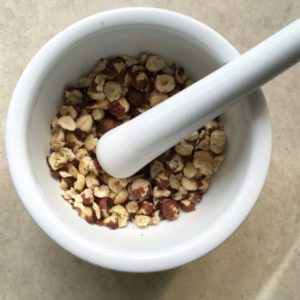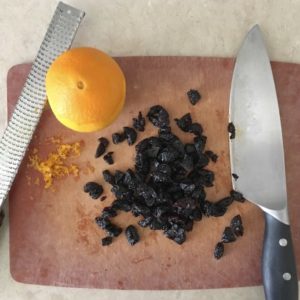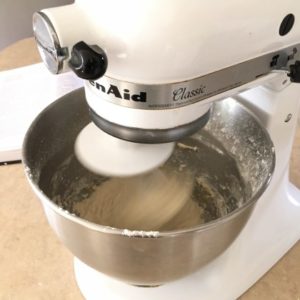
A little over a year ago, my dear friend (and fellow graduate student) Kimberly and I had an idea: to cook our way through an entire cookbook. Think Julie & Julia, but with more camaraderie and a tighter budget. We settled on David Lebovitz’s My Paris Kitchen because it boasted solid reviews, stunning photos, and stories about Paris that delighted us with their enthusiasm and their sarcasm. (Sorry, France, I love you, but you do bring it on yourself sometimes.)


And so, every Sunday night for a year, Kimberly and I convened in her kitchen or mine to chop, sauté, braise, boil, and bake. She is impatient with processes—why does hot cheese take so long to cool?—and hates buttering baking dishes. I am far too cavalier about touching hot pans and foods. We came to refer to David Lebovitz as “Daveed” and talked about him as if he were in the kitchen. (“Daveed didn’t explain what milkshake-like consistency meant!”) But we shopped, chopped, cooked, ate, counseled, and laughed together, proving that the very best thing about food is how it brings people together. (And that is saying a lot coming from someone who can rhapsodize about eggs simmered in tomato sauce.)
We made it 85 recipes deep before Kimbo had to decamp to Mexico City for a year of research. So now the project we call Our Paris Kitchen has about 30 more recipes to go. It’s more leftovers without her, but a little less fun.


This fougasse was a nice way to dip in a toe on flying solo.
Fougasse is basically “bread with things in it,” and even then not always. The historically inclined among us will be interested to learn that it is the French version of Italy’s focaccia–both derived from panis focacius, a Roman bread cooked in the ashes of the hearth. A quick Google search of fougasse recipes reveals that most commonly, fougasse is flecked with provençal herbs and olives and slashed in a leaf-shape. (Nb: this leaf shape makes it far too easy to pull off “just one more piece” of this bread, no knife necessary.)
In Daveed’s Paris kitchen, chocolate, hazelnuts, and dried cherries take the place of herbs and olives—a man after my own heart. The draw here is that the goodies are added in near-equal proportion to the flour, so what comes out of the oven is really a tangle of sour cherries, hazelnuts, and melting chocolate, held together by bread. I can see this making a delightful weekend brunch treat, with the leftovers serving as weekday lunch snacks. I will also openly admit to having stuffed a wrapped half-loaf in the back of my jersey for a long bike ride. It’s like trail mix, right?
Whether you enjoy it at home or work or on the bike: bon appétit!
Note: this bread is not difficult, but it does require two rises, for a total inactive time of 2 1/2 hours.


Chocolate, cherry, and hazelnut fougasse
Makes two loaves that disappear very quickly
Taken from David Lebovitz‘s My Paris Kitchen
Ingredients
1 cup tepid water
1 teaspoon active dry yeast
1 tablespoon granulated sugar
2 tablespoons olive oil, plus more for brushing
2 1/4 cups plus 2 tablespoons all-purpose flour
1 teaspoon sea salt or kosher salt
4 oz (or one huge, heaping cup) bittersweet or semi-sweet chocolate, coarsely chopped
1/2 cup hazelnuts, toasted and coarsely chopped (I bash mine in a mortar and pestle)
1/2 cup dried unsweetened cherries, coarsely chopped
Finely grated zest of 1 orange
Flaky sea salt
Instructions
Pour the water into the bowl of a stand mixer fitted with the dough hook. Sprinkle the yeast over the water. Add the sugar and olive oil and then stir in 1 1/4 cups of the flour until a paste is formed. Let sit 15 minutes, until foamy.
Add the salt and the remaining 1 cup plus 2 tablespoons of flour. Attach the bowl to the standmixer and knead on medium-high speed for 5 minutes. (You can also knead it by hand on a lightly floured surface.) Add the chocolate, hazelnuts, cherries and orange zest and continue mixing for a few more minutes until everything is well incorporated. Cover the mixer bowl and let the dough rise for 1 1/2 hours, or until doubled in bulk.
Line two baking sheets with parchment paper, lightly oil the baking sheets, or put down a non-stick baking mat.
Once the dough has risen, scrape it onto a lightly floured surface and knead it briefly. Cut it into two equal pieces. Use a rolling pin to roll each piece into an oval approximately 6 to 8 inches.
Starting 1 inch from the edge, with a very sharp knife, slash one oval of dough lengthwise down the centre, cutting all the way through the dough, stopping before you reach the other edge. Use the knife to make two nearly parallel slashes — but slightly diagonal, with the cuts starting close to the outer edge and stopping before you reach the centre — on both sides of the initial lengthwise slash.
Transfer the dough to one of the prepared baking sheets. (You may need to do this quickly and carefully, especially if your kitchen is warm and the dough has softened.) Pull the dough out from where you’ve made the slashes, creating open spaces where you’ve slashed the dough, so the bread is about 8 by 10 inches. Repeat the process with the other oval of dough. Cover both loaves with plastic wrap and let rise for 1 hour.
Preheat the oven to 375F about 10 minutes before you’re ready to bake the breads.
Remove the plastic and brush each bread very gently with a light coating of olive oil (try not to deflate the breads), then sprinkle each with an even dusting of flaky salt. Bake the breads for about 15 minutes, rotating the baking sheets in the oven midway during baking, until golden brown on top. Remove from the oven and slide the breads from the baking sheets onto a wire cooling rack. The fougasse is best eaten fresh the day it is made, but it will keep for a few days at room temperature, wrapped in a kitchen towel. You can freeze the second loaf, well wrapped, for up to 2 months.
My relevant cultural tidbit regarding fougasse: this is actually what the Genovese call focaccia in their local dialect! (“Fugassa,” I think, to be precise). Language crossovers ftw.